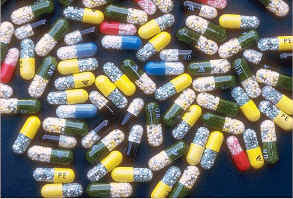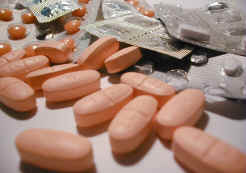 Home
Search This Site
Chiropractic Articles
Home
Search This Site
Chiropractic Articles
Adverse Drug Reactions Kill Over 100,000 In Hospitals Annually.This statistic is according to a recent article appearing in The
Journal of American Medical Association. The author, Bruce Pomeranz, M.D., Ph.D., reviewed
39 different studies of adverse drug reactions in hospitals, and came up with some
alarming Adverse drug reactions as defined in this study were not small problems. These reactions were only included in the study if they required hospitalization, prolonged hospitalization, caused permanent disability or resulted in death. Probably the most surprising finding of the study is that the rate of adverse drug reactions has not changed over the last 32 years. This suggests that despite an increase in cost and technology, the drug related care given in hospitals has not improved its safety level or its death rate in over three decades. Prescription Drug Use On Rise In a related story, it seems that the threat of serious adverse drug reactions has not decreased the usage. In an article in the January 7, 1999 New England Journal of Medicine, it was reported that, "Prescription drugs are the fastest-growing component of personal health expenditures amounting to $78.9 billion in 1997." This rate of consumption is growing at an ever-increasing rate. In 1995 spending for prescriptions grew by 10.6 percent, in 1996 it grew by 13.2 percent and in 1997 it continued the climb growing by 14.1 percent. The Federal Office of Personnel Management blames the increase on several factors. They cite broader insurance coverage of prescription drugs, growth in the number of drugs dispensed, more approvals of more expensive drugs by the Food and Drug Administration, and direct advertising of pharmaceutical products to consumers. It wasn’t too many years ago that they government forced the removal of cigarette advertising off television because of the health hazard. Considering the numbers, maybe its time to take a long hard look at the drug ads. Over 106,000 Drug Related Deaths per YearThe Over-the-counter ulcer medications linked to 16,500 deaths last year.In a December 1, 1998 story in the USA Today comes a story whose first sentence reads, "About 16,500 Americans died last year from bleeding stomach ulcers brought on by common medications known as non-steroidal anti-inflammatory drugs, (NSAIDs)". For a comparison this was close to the number of deaths resulting from AIDS. Unfortunately for the victims bleeding stomach ulcers have no warning symptoms in 80% of the people who have them. Only 20% experience some symptoms such as abdominal pain or heartburn. Some of the more common drugs that fit into this category are Motrin and Aleve as well as the prescription drug Relafen. While these drugs are some of the most common of their type on the market it seems the public does not recognize the danger. A recent national poll done by Roper Starch Worldwide showed that 75% of the people taking NSAIDs were either unaware, or unconcerned about the possible deadly effects. Unfortunately, those most at risk are those most likely to use the drug, including people with severe arthritis and those over 65 years of age. What this article doesn’t mention is that a growing number of these individuals are seeking non-drug solutions such as chiropractic. This approach eliminates the chance of serious complications and adverse effects from these drugs. Drugs not answer for Health & WellnessIn a feature article in the November 16, 1998 issue of the U.S.News & World Report, it was noted that drug usage is actually going up in the US. Drug companies are certainly not crying the blues because of the trend toward health and wellness. In fact they have shifted their emphasis in sales. More and more drug companies are pushing drug usage not only for treatment but for usage before any problems arise as a preventative. This mass marketing shift has paid off as prescriptions for drugs went up 400 million from 1993 to 1997, up to an astounding 2.4 billion prescriptions being dispensed in 1997! This new approach markets drugs with the promise to prevent such things as heart attacks, cancer, osteoporosis, diabetes and impotence. Unfortunately, many of the drugs being marketed for healthy people to take as a preventative, were only tested on sick people. The article in U.S.News & World Report used the example of two drugs called Tambocor and Enkaid. These two drugs were routinely prescribed for years as a preventative of sudden heart attacks. Only after some time did a study of these drugs on healthy people reveal that the drug greatly increased the chance of sudden heart attacks when taken by healthy people. It is estimated that 50,000 people as a result of these drugs may have died before a halt was instituted. The bottom line is that "better living through chemistry" may exact a terrible price.
Annual Death Rate Due to Medications Continues to Rise!The following is reprinted from a recent article in the Boston Globe entitled, "Medication-Error Deaths Soar in U.S.," by Richard A. Knox, "The incidence of death due to medication errors increased dramatically between 1983 and 1993 and shows no signs of abating, new research on the subject shows. Over the ten-year period in question, patient deaths due to medication leaped 260 percent overall, and 850 percent among persons receiving outpatient care. And these figures may represent "only the tip of the iceberg," according to David Phillips of U.C. at San Diego, who points out that many prescription error deaths aren't listed as such on death certificates. Death certificates from the ten-year period provided the raw data on which the findings are based. Researchers involved in the study say that the increase in medication fatalities cannot be attributed simply to patients taking larger-than-prescribed doses of medication. Their comments are borne out by the fact that the sharpest increase in such deaths among outpatients occurred with the use of anesthetics. Anesthesia drugs are not self-administered, suggesting that the increase in outpatient care as part of overall cost-cutting measures among hospitals may be part of the problem. The study found that deaths due to anesthetics among outpatients increased 400 percent compared to anethesia deaths occurring in hospitals. Surprisingly, the steep rise in medication deaths is not due to an increase in prescriptions, which during the ten-year period rose 39 percent, compared to the 260 percent increase in medication error deaths. Compounding the problem, according to research conducted by Harvard University, is the fact that medication errors commonly occur even in the nation's highest-ranking teaching hospitals. The findings clearly indicate the need for a close reexamination of modern medicine's over-reliance on drug use and symptom care as primary approaches for treating illness." Drug Companies Marketing Aimed Directly At Consumers A revolution in drug marketing and sales has occurred. In the early 1990’s a little known drug was introduced to doctors for blood pressure. The drugs name was minoxidil. This drug, as all others before it, was only advertised in professional journals to medical doctors. Then, when someone noticed that this drug actually stimulated some hair growth, things changed. This little known drug was soon known as Rogaine. And the marketing was not aimed solely at doctors, but directly to the consumer. This changed the prescription drug game totally. Prior to that most consumers only saw over-the-counter drug advertisements. Now, the drug companies are advertising the prescription products right to the consumer. The results are predictable. An article in the January 7, 1999, New England Journal of Medicine reports, "Prescription drugs are the fastest-growing component of personal health expenditures amounting to $78.9 billion in 1997". This rate of consumption is growing at an ever-increasing rate. In 1995, spending for prescriptions grew by 10.6 percent. In 1996, it grew by 13.2 percent, and in 1997, it continued the climb growing by 14.1 percent." Based on the drug industries own figures, the top ten drug makers have spent 44% more money to advertise prescription drugs to consumers than to doctors. Claritin, a well advertised drug is one example where the makers spent over $70 million in 1998 advertising to doctors, while spending $183 million advertising to consumers. The government, seeing the potential for abuse, has started to create guidelines for prescription drug advertisements. These guidelines are designed to inform consumers of major side effects of the advertised drugs, and give ways to get further information on their various reactions. Considering that children learn a lot about our world from television, we must consider if the drug companies message of "better living through drugs" is one we want our future generations to repeatedly see. (Fortunately Chiropractic is a drugless health profession that deals with correcting causes and not just treating effects.)
|
 conclusions. According to Pomeranz’s research, he estimates that 2,216,000
hospital patients experienced serious adverse drug reactions (side effects) and 106,000
died from these reactions in 1994 alone. This astounding number accounted for 4.6% of all
recorded deaths in the U.S. in that year. This makes drug reaction deaths the fourth
leading cause of death in the country.
conclusions. According to Pomeranz’s research, he estimates that 2,216,000
hospital patients experienced serious adverse drug reactions (side effects) and 106,000
died from these reactions in 1994 alone. This astounding number accounted for 4.6% of all
recorded deaths in the U.S. in that year. This makes drug reaction deaths the fourth
leading cause of death in the country. USA Today, Wednesday, April 15, 1998, page 1 finds a report on a
recent article in the Journal of the American Medical Association addressing the subject
of unintended side-effects of properly prescribed, properly administered medications. The
authors estimate deaths from such events to exceed 106,000 deaths per year. To offer some
perspective on this number--57,000 US soldiers died in the Vietnam War! Keep in mind, this
number represents a completely different data set than Lucian Leape's estimate of 180,000
hospital based iatrogenic deaths per year. Those deaths are associated with errors, not
side effects of properly prescribed and administered medications.
USA Today, Wednesday, April 15, 1998, page 1 finds a report on a
recent article in the Journal of the American Medical Association addressing the subject
of unintended side-effects of properly prescribed, properly administered medications. The
authors estimate deaths from such events to exceed 106,000 deaths per year. To offer some
perspective on this number--57,000 US soldiers died in the Vietnam War! Keep in mind, this
number represents a completely different data set than Lucian Leape's estimate of 180,000
hospital based iatrogenic deaths per year. Those deaths are associated with errors, not
side effects of properly prescribed and administered medications.